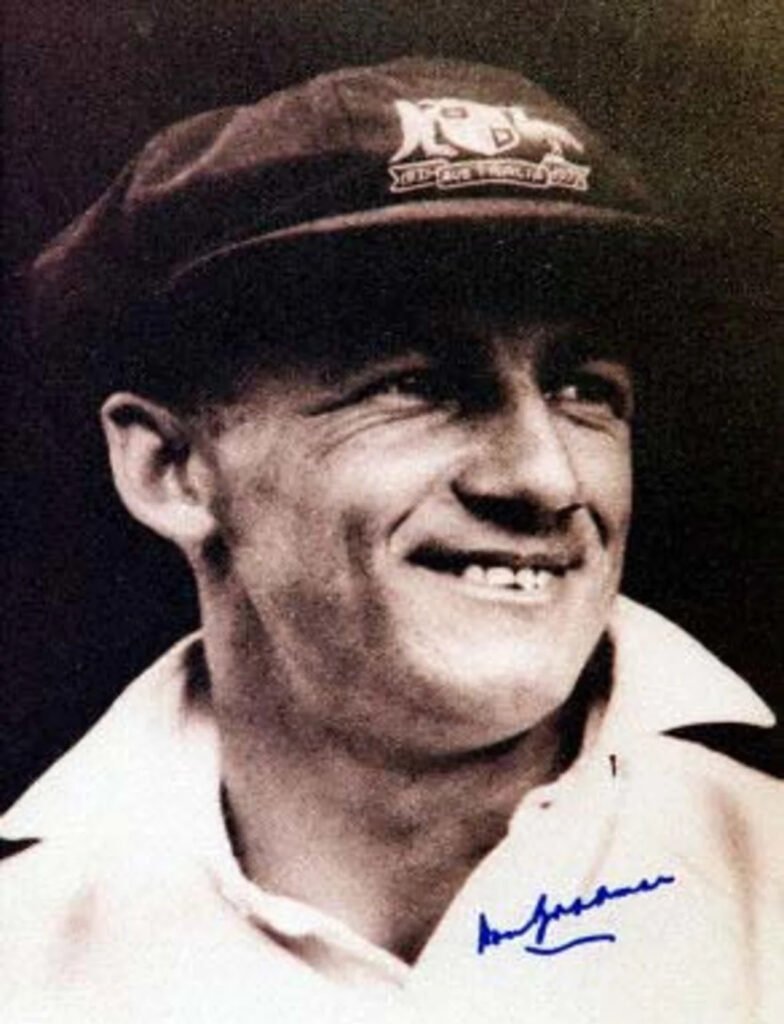Sir Donald Bradman: The Greatest Cricketer of All Time; Staggering Test Average of 99.94
Sir Donald Bradman, known as the greatest batsman in cricket history, left an indelible mark on the game and sportsmanship.
His unparalleled achievements on the pitch and his enduring legacy off it make him a timeless figure in the annals of cricket history.
DON BRADMAN’S CAREER STATS
FORMAT | MAT | INNS | RUNS | HS | AVE | 100S | 50S |
TESTS | 52 | 80 | 6996 | 334 | 99.94 | 29 | 13 |
FC | 234 | 338 | 28067 | 452* | 95.14 | 117 | 69 |
Without a doubt, Australia’s Sir Donald Bradman was the greatest cricketer of the 20th century and the best batsman in history. In the early years of the game, only WG Grace came close to matching his standing as a player. And more than fifty years after he retired, The Don continued to live into the twenty-first century. His stature as a player, manager, selector, wise man, and statesman of cricket only grew during that period. His impact went beyond athletics; his achievements altered Australia’s ties to the former “mother country”.
Bradman was the greatest cricket player in the world throughout the 1930s and 1940s; he was so much superior to everyone else that it was useless to make comparisons.
Also Read: Australia Triumphs Over New Zealand to Win Their 5th WC Title
Also Read: Ricky Ponting: A Legendary Cricket Career
Australia lost the Ashes only once, in 1932–1933, when England were so intimidated by Bradman that they created the infamous Bodyline bowling system, which history has condemned as being cruel and unfair, in order to thwart him. In 1930, he scored 974 runs in the series, 309 of them in one incredible day at Headingley. In the series, he nevertheless averaged 56.
He made 29 hundreds and went to the crease 80 times in Test cricket. In 1948, he only needed to make four runs in his final Test innings at The Oval to secure an average of 100. However, he was out the second ball for zero, an uncommon instance of human error that only served to heighten his enduring allure. Bradman was able to make all those fast runs in a way that confused opponents and captivated fans. His hitting was always amazing even though it wasn’t particularly beautiful.
“He’s out!” – the two words splashed over the London evening newspaper banners could have meant only one thing to the thousands of people who read them, cricket enthusiasts or not: somewhere, someone had succeeded in dismissing Don Bradman, which in and of itself was a claim to fame that would last a lifetime.
Without a doubt, the greatest phenomenon in the history of cricket, if not all ball games, was Sir Donald George Bradman. To begin with, he was naturally highly gifted and had a profound and unwavering love for cricket. It was often said that if he had chosen these sports over cricket, he could have become a champion in squash, tennis, golf, or billiards.
He demonstrated his eye, dexterity, and uncommon ability to focus even at a young age by practicing his reflexes and strokes as a youngster by hitting a golf ball with a cricket stump as it bounced off a water tank.
Bradman felt that there were other batters, his contemporaries, who were talented enough to be equally as productive as he was, but not as focused. Undoubtedly, one among them was Stan McCabe, who required a specific challenge to unleash his full potential.
When asked which batsman he had played with the best, Bradman’s response after McCabe’s 232 in the 1938 Trent Bridge Test, “I wish I could bat like that,” must rank alongside W.G.’s “Give me Arthur” (Shrewsbury) as the greatest compliment a great cricketer has ever given to another.

Thus, along with the focus, dedication, forethought, and confidence that were emblematic of Bradman came a less conspicuous yet no less telling humility. He drew praise and sought solitude.
How did anyone ever get him out? The two bowlers who did it most frequently, albeit occasionally at exorbitant expense, were both spinners: spinners Clarrie Grimmett (who had ten leg-break and googly coups to his name) and Hedley Verity (who also had 10, eight of them for England). I wonder if we can infer anything from this. For instance, Bradman may have been discouraged from springing out to drive—something he was always attempting to do—because both had a flattish trajectory.
It turns out that Grimmett wasn’t the only one who could make the great man appear almost mortal at times. And it was with a googly that Eric Hollies bowled him for a duck in his final Test innings, at The Oval in 1948, when he was within four runs of averaging 100 in Test cricket. Bill O’Reilly was another; Bradman called him the finest and, therefore, presumably, the most testing bowler he played against.
It’s possible that he occasionally struggled to discern wristspin, but that’s the sneaky intent behind it.
Bradman, by his own peculiar standards, was discomfited by Bodyline, the blatantly offensive tactic Douglas Jardine used to remove him from office in Australia in 1932–1933.
Discomfited, to be sure, but he finished the Test series with an average of 56.57. If his incredible record had a real stain, it would have to be the lack of a memorable innings on one of those “sticky dogs” in the past, when the ball was cavorting and hissing in the hot sun after a lot of rain. This is not to argue that he couldn’t have played one, only that he never did when the opportunity presented itself on the big stage.
On all other occasions, he was completely in control. The Don was described by R. C. Robertson-Glasgow as “that rarest of Nature’s creatures, a genius with an eye for business.” He may still be scampering the first run to third man or long leg with 250 not out in the hopes of forcing a fielding error.
If modern batsmen saw that, they would be astounded and would become better players as a result. Though apocryphal, he could have meant it if, to an admiring observer, he really wish that his 309 not out on the first day of the Headingley Test of 1930 would be a good rehearsal for tomorrow.
He is aware, more than anybody else, that his 309 from 70 years ago would be closer to 209 now because to the increased focus on containment and the decreased number of overs bowled. Which is why it was even more fortunate that he played when he did because it gave him the opportunity to both reinvent a game and revitalize a country. Like W.G., he will always be famous. Cricketers’ Almanack of Wisden.






